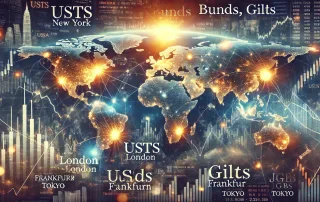Weapons Shipments to Ukraine: A Hidden Gem for Forex Traders

The Great Arsenal Shuffle: What It Means for Forex Traders
Imagine the FX market like a game of chess. Sometimes you’re calculating your next move with pinpoint precision—other times, an unexpected player like North Korea flips the board. Welcome to the unexpected world of market forces, where news like the latest arms shipments to Ukraine is a game-changer in disguise, and you, dear trader, need to know how to stay three moves ahead.
Just recently, the U.S. decided to bolster Ukraine with an extra $275 million in weaponry, plus approved the provision of antipersonnel mines, all aimed at bracing Kyiv for… well, more volatility. Whether it’s Biden okaying mines or North Korean troops popping up alongside Russia’s airborne divisions like the ultimate plot twist, there’s more going on here than just warfare—it’s a subtle shift that sends ripples across financial markets. But here’s where the magic happens—these ripples can turn into waves that impact your trading strategy.
You see, behind these headlines lie hidden opportunities—and some cleverly masked risks—that can either be the wind in your portfolio’s sails or the iceberg to its Titanic. But we don’t do icebergs here. So, what does the secret playbook say? Let’s uncover the moves that others miss.
Hidden Patterns in Geopolitical Drama
If you’re trying to predict forex market moves using simple logic, spoiler alert: it’s more like a Hollywood blockbuster with too many plot twists. Case in point: North Korean troops, of all people, showing up to help out Russia. You didn’t see that coming, did you? When these kinds of wildcard geopolitical events unfold, they don’t just impact the battlefield—they shift the mood across the entire FX chessboard.
Contrarian traders out there, get ready. This “surprise guest appearance” by North Korea could be an indicator to closely watch currencies in regions like Asia-Pacific, where market participants might interpret the news with their own brand of apprehension. Fear sends traders flying to safety nets, often benefiting stalwarts like the Japanese yen or the Swiss franc.
The Intricacies of Global Weapons Supply Lines
While on the surface it sounds like a news brief from any war-torn region, the underlying dance of weapons shipments—whether from the U.S. to Ukraine or North Korean howitzers making a clandestine entry into Russia—creates price action that’s worth a second glance.
Forex traders with an eye on the pulse know this: military assistance directly correlates with confidence—or lack thereof—in the region’s economic stability. In simple terms? This means a potential weakening of regional currencies that are associated with or in proximity to the conflict. Markets don’t like instability; they seek stability the way shoppers at a grocery store hunt for discounts—fiercely and swiftly.
So, what’s the secret here? It’s all about following the trail—watching which countries provide or receive aid, and seeing how they influence their trading partners’ currencies. The ripple effect from supplying weapons is like throwing a boulder into a pond—massive ripples that savvy traders ride with strategic timing.
The Overlooked Trading Tactic: Shelter-in-Place News
Here’s where things get really interesting—the U.S. Embassy in Kyiv issued an alert about a significant air attack and suggested people prepare to shelter in place. Traders often see these warnings as a cue for increased economic uncertainty.
But here’s a twist: a lesser-known advanced strategy involves treating these heightened risk periods as opportunities to move into highly liquid assets temporarily, aiming for a strategic re-entry into higher-risk trades once the dust settles. Why, you ask? Because liquidity is king during uncertain times. The smart move here is to wait for the inevitable knee-jerk reactions that swing the pendulum far from equilibrium—and position for the reversal.
Takeaway tip: Keep your eyes on liquid pairs like EUR/USD, which often act as havens during times of rising tensions. Not only are they easier to maneuver in times of crisis, but the spread impact during high volatility periods is notably reduced.
How to Anticipate Market Moves Like a Pro
Think of major geopolitical events like a Rube Goldberg machine, with one piece setting off the next in a complex chain reaction. For the astute Forex trader, it’s all about mapping out where that chain leads next.
Let’s break down a step-by-step guide to using geopolitical developments to anticipate market moves:
- Identify the Trigger Event: Here, it’s the influx of weaponry or the latest major diplomatic move (i.e., Biden’s green light for antipersonnel mines).
- Assess Immediate Reaction Areas: Consider how major world powers and currencies (USD, EUR, JPY) will be influenced by the escalating situation.
- Monitor Secondary Ripple Effects: Events like North Korean troops getting involved trigger fear-based reactions in regional economies.
- Prepare for Volatility Reversals: After the initial spike in risk-off behavior, prepare for retracement opportunities—this is where significant value is often found.
The Power Play: How to Trade Amidst Tensions
If tensions continue to escalate—think fresh arms shipments, threats from new players like North Korea, or calls for citizens to shelter—the forex market will continue to see increased volatility. As a trader, volatility isn’t your enemy—it’s a gateway to opportunity.
The smart move here is not to shy away from turbulent waters but to dive right in with the right life jacket on. Enter the USD. You see, when uncertainty climbs, the USD tends to gain strength as the world’s favorite ‘safe haven.’ There’s always a consistent influx into the greenback when global confidence shakes, which makes trading USD pairs—especially against currencies tied to conflict regions—a solid play.
Consider it a natural hedge. Stay on the lookout for buying opportunities with USD/CAD or EUR/USD during escalated risk periods, but—and here’s the hidden gem—pay close attention to liquidity. When fear reigns, low liquidity can create wild price gaps. This is where tight stop losses and even tighter spreads come into play.
What Lies Beneath the Headlines
Headlines grab your attention, but it’s the underlying currents that matter. A U.S. Embassy warning about sheltering from air attacks may sound dire, but for a forex trader, it’s a heads-up for short-term volatility and safe-haven shifts. North Korean troops battling alongside Russia? That’s your cue to track Asia-Pacific sentiment and watch for haven flows to JPY.
Remember, beneath the doom-and-gloom headlines, there are hidden forces shaping market moves—and opportunities that most traders miss. Keep an eye on contrarian indicators, military support nuances, and strategic currency pair plays.
- The U.S. sending antipersonnel mines to Ukraine signals a long-term investment in the region’s defense. Translation? Short-term economic instability, long-term EUR/USD recovery opportunities.
- North Korean involvement hints at Asia-Pacific unrest—watch JPY for movement towards safety.
- Don’t ignore embassy warnings—these often precede short-term, risk-off shifts. Think safety first: USD or JPY.
The forex market has enough chaos to rival a binge-worthy thriller—stay sharp, stay informed, and keep a finger on the pulse of world events to stay one step ahead of the game.

Anne Durrell
About the Author
StarseedFX delivers timely Forex news and market insights, thoughtfully edited and curated by Anne Durrell. As a seasoned Forex expert with over 12 years of industry experience, Anne turns complex market shifts into clear, engaging, and easy-to-understand updates.
From decoding the latest trends to writing her own in-depth analyses, Anne ensures every piece is both informative and enjoyable. If you found this article helpful, don’t forget to share it with fellow traders and friends, and leave a comment below—your insights make the conversation even richer! Follow StarseedFX for fresh updates and stay ahead in the dynamic world of Forex trading.






